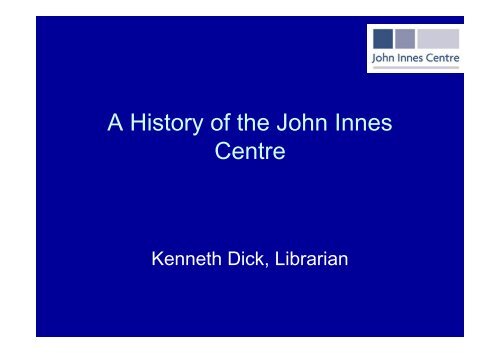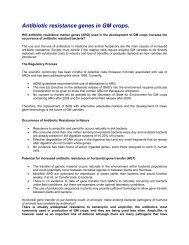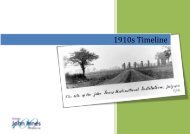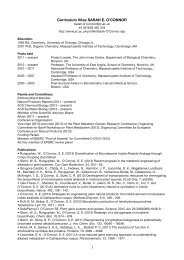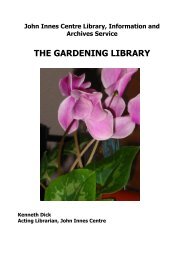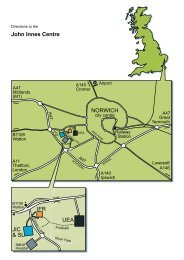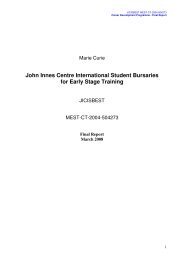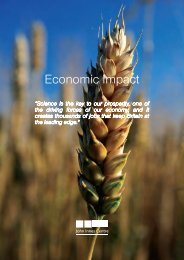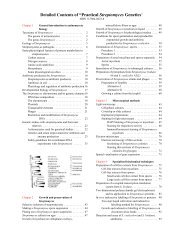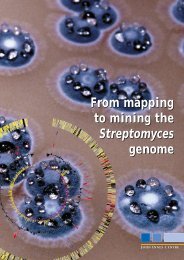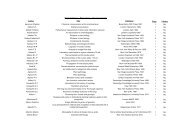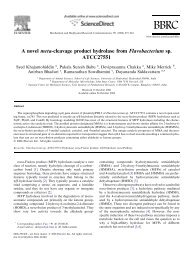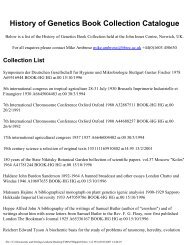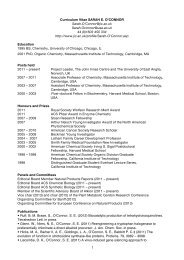A History of the John Innes Centre
A History of the John Innes Centre
A History of the John Innes Centre
You also want an ePaper? Increase the reach of your titles
YUMPU automatically turns print PDFs into web optimized ePapers that Google loves.
A <strong>History</strong> <strong>of</strong> <strong>the</strong> <strong>John</strong> <strong>Innes</strong><br />
<strong>Centre</strong><br />
Kenneth Dick, Librarian
Who Was <strong>John</strong> <strong>Innes</strong><br />
• <strong>John</strong> <strong>Innes</strong> was born<br />
on 6 th January 1829<br />
at Hampstead<br />
• <strong>John</strong> <strong>Innes</strong> died a<br />
bachelor on <strong>the</strong> 8 th<br />
August 1904 at<br />
Merton
What did <strong>John</strong> <strong>Innes</strong> do?<br />
• The <strong>Innes</strong> family business owned sugar<br />
plantations in Jamaica and imported rum<br />
into England<br />
• All members <strong>of</strong> <strong>the</strong> family were supporters<br />
<strong>of</strong> <strong>the</strong> campaign against slavery in <strong>the</strong><br />
West Indies<br />
• Business interests in Jamaica were sold
What did <strong>John</strong> <strong>Innes</strong> do?<br />
• City <strong>of</strong> London Real Property Company<br />
• Purchased land in Merton park in 1864<br />
and created Merton Park Estate Company<br />
• Purchased Manor house at Merton with<br />
about 12 acres <strong>of</strong> land
Merton Manor House
The Bequest<br />
• Most <strong>of</strong> <strong>the</strong> grounds <strong>of</strong> <strong>the</strong> Manor House<br />
were to be converted into a public park<br />
for <strong>the</strong> benefit <strong>of</strong> <strong>the</strong> residents <strong>of</strong> <strong>the</strong><br />
parishes <strong>of</strong> Merton and Morden.<br />
• The Manor House and 2 acres <strong>of</strong> ground<br />
were set aside from this park.
The Bequest<br />
• School <strong>of</strong> horticulture<br />
– “technical instruction in <strong>the</strong> principles <strong>of</strong> <strong>the</strong><br />
science and art <strong>of</strong> horticulture and <strong>the</strong><br />
application <strong>the</strong>re<strong>of</strong> to <strong>the</strong> industry or<br />
employment <strong>of</strong> gardening”<br />
– “provide <strong>the</strong> training mental or physical<br />
necessary for <strong>the</strong> above purpose”<br />
•Or<br />
• Public museum for <strong>the</strong> collection <strong>of</strong><br />
paintings and o<strong>the</strong>r works <strong>of</strong> art.
The Bequest<br />
• <strong>John</strong> <strong>Innes</strong> appointed 3 trustees to carry<br />
out <strong>the</strong> will<br />
– Frederick George Courthorpe<br />
– Charles Clare Scott K.C.<br />
– William Ernest Reid <strong>Innes</strong><br />
• Board <strong>of</strong> Agriculture learnt <strong>of</strong> <strong>the</strong> bequest<br />
through <strong>the</strong> newspapers
The Bequest and <strong>the</strong><br />
Scheme<br />
• 1906 – Trustees asked <strong>the</strong> Charity<br />
Commissioners to prepare a scheme<br />
• 1908 – Scheme is approved by both<br />
Trustees and Board <strong>of</strong> Agriculture<br />
•12 th January 1909 – Scheme comes into<br />
force<br />
• 1910 <strong>John</strong> <strong>Innes</strong> Horticultural Institution<br />
Opens
The Scheme<br />
• School in which practical working<br />
gardeners could be trained<br />
• Fruit-breeding research station<br />
• “Institution, for <strong>the</strong> promotion <strong>of</strong><br />
horticultural instruction, experiment and<br />
research”
The Scheme<br />
• Advisory Council membership<br />
– 3 Trustees, 2 members appointed by <strong>the</strong><br />
Board <strong>of</strong> Agriculture<br />
– 1 Member from each <strong>of</strong> Oxford, Cambridge<br />
and London Universities, Imperial College <strong>of</strong><br />
Science and Technology, Royal Horticultural<br />
Society, Fruiterer’s Company and <strong>the</strong> National<br />
Fruit Growers’ Federation
Purpose <strong>of</strong> <strong>the</strong> Institute<br />
• “The promotion <strong>of</strong> Investigation and Research <strong>of</strong> a<br />
Practical and Scientific Nature having reference to <strong>the</strong><br />
growth <strong>of</strong> trees and plant generally, but especially <strong>of</strong> fruit<br />
trees, shrubs, fruit, vegetables and flowers and that <strong>the</strong><br />
imparting <strong>of</strong> practical and scientific knowledge to those<br />
engaged or desiring to be engaged, in <strong>the</strong> industry or<br />
employment <strong>of</strong> horticulture, should be made to follow<br />
incidentally from, and to be dependent upon, <strong>the</strong><br />
operations required to effect that primary object…. We<br />
are also <strong>of</strong> <strong>the</strong> opinion that <strong>the</strong> practice <strong>of</strong> scientific plant<br />
breeding and <strong>the</strong> endeavour to improve existing varieties<br />
and to introduce new ones, is inseparably bound up with<br />
<strong>the</strong> practical investigation and research which should<br />
form <strong>the</strong> object <strong>of</strong> <strong>the</strong> Institution.”
Purpose <strong>of</strong> <strong>the</strong> Institute<br />
• <strong>John</strong> <strong>Innes</strong> School for Gardeners<br />
– 6 two-year studentships were awarded to men<br />
who had already completed four years <strong>of</strong><br />
practical gardening experience<br />
– Many <strong>of</strong> <strong>the</strong>se students went on to become<br />
successful gardener’s or returned to <strong>the</strong><br />
Institution as scientists in later times
A Key person<br />
• Sir David Prain (1857 –<br />
1944)<br />
• Was instrumental in <strong>the</strong><br />
<strong>John</strong> <strong>Innes</strong> Horticultural<br />
Institution working in <strong>the</strong><br />
field <strong>of</strong> plant genetics<br />
• 1 st Chair <strong>of</strong> <strong>the</strong> Advisory<br />
Council
Key Staff (1)<br />
• William Bateson (1861 –<br />
1926)<br />
• 1 st Director <strong>of</strong> <strong>the</strong> JIHI<br />
• Coined <strong>the</strong> word<br />
‘genetics’ to cover <strong>the</strong><br />
study <strong>of</strong> heredity and<br />
variation<br />
• Established <strong>the</strong> actual<br />
lines <strong>of</strong> research within<br />
JIHI<br />
• Genetical Society
Bateson’s Women<br />
• Unusually for <strong>the</strong> time Bateson was a<br />
supporter <strong>of</strong> female academic work and<br />
research employing a number <strong>of</strong> women<br />
scientists within JIHI<br />
– Dorothy Mary Cayley<br />
– Caroline Pellew<br />
– Doro<strong>the</strong>a de Winton<br />
– Alice Elizabeth Gairdener<br />
– Muriel Wheldale
Key Staff (2)<br />
• M B Crane (1890 –<br />
1983)<br />
• Was appointed as<br />
pomologist in 1928<br />
and became first<br />
head <strong>of</strong> Pomology<br />
department in 1937
Key Staff (3)<br />
• C D Darlington (1903<br />
– 1981)<br />
• 1927 Appointed<br />
Institute Cytologist<br />
• 1936 Appointed Head<br />
<strong>of</strong> Cytology<br />
Department<br />
• 1939 Appointed 3 rd<br />
Director <strong>of</strong> JIHI
Darlington’s Work<br />
• Study <strong>of</strong> Chromosomes<br />
• Stressed <strong>the</strong> importance <strong>of</strong> chromosomes<br />
to genetics<br />
• Publication <strong>of</strong> ‘Recent advances in<br />
cytology’ and ‘Chromosomes and Plant<br />
Breeding’ in 1932 saw some refer to<br />
Darlington as <strong>the</strong> ‘Newton <strong>of</strong> cytology’
Key Staff (4)<br />
• A D Hall (1864 –<br />
1942)<br />
• 2 nd Director JIHI<br />
• Expert in soils,<br />
agriculture and tulips
Key Staff (5)<br />
• J B S Haldane (1892<br />
– 1964)<br />
• Worked on linkage in<br />
Primula sinensis and<br />
Antirrhinum majus<br />
• Popularising science
Key Staff (6)<br />
• W J C Lawrence<br />
(1899 – 1985)<br />
• Ambition was to be a<br />
geneticist<br />
• Glasshouse design<br />
• Plant physiology<br />
• <strong>John</strong> <strong>Innes</strong> Composts
<strong>John</strong> <strong>Innes</strong> Composts<br />
• Developed after <strong>the</strong> failure <strong>of</strong> <strong>the</strong> 1933 Primula<br />
sinensis crop<br />
• Developed to provide a reliable and repeatable<br />
compost soil for experimental work<br />
• The Institute has never produced <strong>the</strong> composts<br />
commercially or benefited financially from <strong>the</strong>ir<br />
production
Key Staff – Visiting<br />
Workers<br />
• N I Vavilov (1887 – 1943)<br />
• Visiting worker at JIHI 1913-1914<br />
• Importance to Soviet agriculture and genetics<br />
• Studied and wrote on <strong>the</strong> origin <strong>of</strong> cultivated<br />
plants
Key Staff (7)<br />
• K S Dodds (1912 –<br />
1987)<br />
• 4 th Director <strong>of</strong> JIHI<br />
• Potatoes were his<br />
primary area <strong>of</strong><br />
research
Key Staff (8)<br />
• R Markham (1916 –<br />
1979)<br />
• 5 th Director <strong>of</strong> JII<br />
• Virus research
Key Staff (9)<br />
• H W Woolhouse<br />
(1932 – 1996)<br />
• 6 th Director <strong>of</strong> JII<br />
(1980 – 1987)<br />
• Oversaw a significant<br />
expansion in <strong>the</strong> size<br />
<strong>of</strong> <strong>the</strong> Institute
Key Staff (10)<br />
• R D Flavell (19 – )<br />
• 7 th Director <strong>of</strong> JII<br />
(1988 – 1998)<br />
• Joined <strong>the</strong> Institute<br />
from <strong>the</strong> Plant<br />
Breeding Institute
Key staff - Summary<br />
Merton 1910-1948<br />
JOHN INNES CENTRE TIMELINE<br />
Bayfordbury<br />
1948-1967<br />
Colney 1967-<br />
W. Bateson<br />
1910-1926<br />
AD Hall<br />
1926-1939<br />
CD Darlington<br />
1939-1953<br />
K.S. Dodds<br />
1954-1966<br />
R.Markham<br />
1967-1979<br />
H.Woolhouse<br />
1980-1987<br />
R.D. Flavell<br />
1988-1998<br />
Chris Lamb<br />
1999-<br />
E Cheeseman<br />
1966<br />
Mike Gale<br />
1998-9<br />
<strong>John</strong> <strong>Innes</strong> Horticultural<br />
Institution 1910-1960<br />
<strong>John</strong> <strong>Innes</strong> Institute<br />
1960-1994<br />
<strong>John</strong> <strong>Innes</strong> <strong>Centre</strong><br />
1994 - present<br />
1910 1920 1930 1940 1950 1960 1970 1980 1990 2000 2010
What did <strong>the</strong> Institute do<br />
- 1911<br />
• Plants worked on:<br />
– Primula Sinensis, Capsicum, Peas, Plums,<br />
Strawberries, Begonia, Cabbages, Sugar Beet,<br />
Antirrhinum, Calceolaria, Nicotiana, Apple, Roses,<br />
Black Currants, Tropaeolum<br />
• O<strong>the</strong>r work:<br />
– Cyanide fumigation, soil sterilisation, fruit-rot<br />
suppression through fumigation, mildew susceptibility<br />
in roses, thrip life histories, specimen identification,<br />
Lace-wings life histories and habits, grease-banding<br />
for winter moth
What did <strong>the</strong> Institute do<br />
- 1938<br />
• Plants worked on:<br />
– Primula sinensis, Pisum, Lathyrus, Maize, Lotus,<br />
Tolmeia, Solanum, Verbena, Tropaeolum, Dahlia,<br />
Streptocarpus, Papaver, Aquilegia, Tulipa, Fritillaria,<br />
Campanula, Prunus, Pyrus, Rubus, Fragaria, British<br />
Flora generally<br />
• O<strong>the</strong>r work:<br />
– Grasshoppers, fruit colour in Prunus, coloration in<br />
autumn and spring leaves, anthocyanin distribution,<br />
pollination and fruit formation, soil sterilisation and<br />
composting
What did <strong>the</strong> Institute do<br />
- 1951<br />
• 1951 Plants worked on:<br />
– Tomatoes, Solanum, Pears, Potatoes, Plums, Sweet Corn, Silage Corn,<br />
Swede, Kale, Kohlrabi, Cabbage, Turnip, Apples, Raspberries,<br />
Cherries, Compositae, Cruciferae, Iberis, Labiatae, Narcissus,<br />
Oeno<strong>the</strong>ra, Antirrhinum, Roses, Primula sinensis, Chrysan<strong>the</strong>mum,<br />
Maize, Trillium, Muscari, Vicia faba, Allium, Hyacinthus, Tradescantia,<br />
Agropyron, Scilla<br />
• 1951 Research Work:<br />
– Leaf-mould resistance, Tomato hybrid vigour, Cyto-Ecology, Fruit<br />
breeding, Breeding systems, Mutation, Controlled room tests,<br />
Interspecific relations, Genetics and chemistry <strong>of</strong> flower pigments, Seed<br />
storage, Chemical breakage <strong>of</strong> chromosomes, Chain reaction <strong>of</strong><br />
chromosome breakage, Secondary nuclei, Breakdown <strong>of</strong> sexual<br />
reproduction, Abnormal meiosis, Bud sports, Rose species collection,<br />
<strong>John</strong> <strong>Innes</strong> Composts, Steam sterilization, Methods <strong>of</strong> raising plants,<br />
Natural illumination, Artificial illumination <strong>of</strong> seedlings, Glasshouse<br />
design
What did <strong>the</strong> Institute do<br />
- 1968<br />
• Plants worked on:<br />
– Anemone, Apple, Asparagus, Antirrhinums, Cherries,<br />
Pea, Solanaceae, Strawberries, Tomato, Onion, Vicia<br />
faba<br />
• Research Work:<br />
– Breeding <strong>of</strong> improved forms <strong>of</strong> anemone coronaria,<br />
Characterisation <strong>of</strong> anemone flower pigments,<br />
Phytotoxin production by venturia inaequalis <strong>of</strong> apple,<br />
Selection <strong>of</strong> haploid asparagus, In vitro propagation <strong>of</strong><br />
asparagus, Effect <strong>of</strong> light quality on growth <strong>of</strong><br />
antirrhinums, (continued)
What did <strong>the</strong> Institute do<br />
– 1968 (2)<br />
• Research work (continued):<br />
– Production <strong>of</strong> non-shattering forms <strong>of</strong> antirrhinums, Breeding for<br />
resistance to bacterial canker in cherries, Neoplastic pod <strong>of</strong> pea,<br />
Pea breeding, Pisum germplasm records, Pea pathogens,<br />
Rogue peas, Cytogenetics <strong>of</strong> <strong>the</strong> solanaceae, An<strong>the</strong>r culture,<br />
Plant cell hybridization, Flavonoids and chlorogenic acids in<br />
tissue culture, The mechanism <strong>of</strong> leaf primordial formation in<br />
tomato, Influence <strong>of</strong> seed age under gnobiotic conditions,<br />
Protein changes in ageing onion seed, Rapid evaluation <strong>of</strong> seed<br />
viability, Effects <strong>of</strong> temperature <strong>of</strong> RNA syn<strong>the</strong>sis in vicia faba,<br />
Mutability <strong>of</strong> antirrhinum majus, The release <strong>of</strong> genetically<br />
blocked anthocyanin in antirrhinum majus by botrytis cinerea,<br />
The nuclear pores at early meiotic prophase, The synaptinemal<br />
complex, The chromomeres and non-recombinational DNA,<br />
(continued)
What did <strong>the</strong> Institute do<br />
– 1968 (3)<br />
• Research work (continued):<br />
– Chromocentres and <strong>the</strong> synaptinemal complex, Ultrastructural studies on<br />
isolated plant mitochondria, Ultrastructural studies on neoplastic growths<br />
associated with pods <strong>of</strong> peas, Electron microscope and optical diffraction studies<br />
on <strong>the</strong> structure <strong>of</strong> isolated cell walls from chlamydomonas reinhardii, Genetical<br />
and morphological studies <strong>of</strong> actinomycetes, Fertility variants <strong>of</strong> streptomyces<br />
coelicolor, The surface structure <strong>of</strong> streptomycete pores as revealed by negative<br />
staining and freeze-etching, The fine structure <strong>of</strong> Streptomyces coelicolor as<br />
revealed by freeze-etching and negative staining, photoreactivation in<br />
streptomyces, Attempts to induce stable heterozygosity in streptomyces, The<br />
isolation <strong>of</strong> phages active on streptomyces coelicolor, An approach to <strong>the</strong><br />
genetics <strong>of</strong> a <strong>the</strong>rmophilic actinomycete, A rapid method <strong>of</strong> lyophilising<br />
actinomycete cultures, Genetic and ultrastructural studies <strong>of</strong> cell wall formation in<br />
chlamydomonas reinhardii, Mapping and characterisation <strong>of</strong> a neurospora<br />
mutant lacking arginase, Alfalfa mosaic virus, Satellite virus 1 <strong>of</strong> tobacco necrosis<br />
virus, Tobacco ringspot virus: an anomalous nucleic acid, Proteins <strong>of</strong> unusual<br />
tomato mosaic virus strains, The isolation <strong>of</strong> nuclei from infected leaf tissue, The<br />
isolation and cytological study <strong>of</strong> a small free insect virus, Transfer <strong>of</strong> RNA <strong>of</strong> leaf<br />
tissue, Iodination <strong>of</strong> plant viruses and <strong>the</strong>ir nucleic acids, The polyamine in plant<br />
viruses, The mechanism <strong>of</strong> negative staining, Nuclear-cytoplasmic interactions in<br />
physarum polycephalum, Quantitatively minor components <strong>of</strong> RNA
Plant Varieties bred at<br />
• Fruit<br />
<strong>John</strong> <strong>Innes</strong><br />
– Apples, Pears, Plums, Cherries, Strawberries,<br />
Blackberries, Rhubarb, Tomato,<br />
• Vegetables<br />
– Haricot bean, Sweetcorn, Mangold, Peas<br />
• Flowers<br />
– Calcaeolaria, Campanula, Columnea, Foxgloves,<br />
Freesia, Trumpet lily, Passiflora x Caponii, Primula<br />
sinensis, Streptocarpus, Tulip
The move from Merton<br />
to Bayfordbury<br />
• Merton 1910 – 1948<br />
• Outgrew <strong>the</strong> space available to it in Merton<br />
Park<br />
• Environmental conditions
The move from<br />
Bayfordbury to Colney<br />
• Bayfordbury 1948 – 1967<br />
• Scientific changes within <strong>the</strong> Institute<br />
• Isolation <strong>of</strong> JII<br />
• Grant-aided institute <strong>of</strong> Ministry <strong>of</strong><br />
Agriculture
The Institute at Colney<br />
• Colney 1967 –<br />
• Links with UEA<br />
• New Governing Council<br />
• New Scheme for JII
New Scheme for JII at<br />
Colney<br />
• The carrying out <strong>of</strong> research in connection with<br />
<strong>the</strong> growth <strong>of</strong> plants and related subjects.<br />
• The improvement <strong>of</strong> existing varieties <strong>of</strong> plants<br />
and <strong>the</strong> creation and introduction <strong>of</strong> new<br />
varieties<br />
• The giving <strong>of</strong> instruction in, and publication <strong>of</strong><br />
information relating to <strong>the</strong> matters specified in<br />
<strong>the</strong> first two paragraphs <strong>of</strong> this clause<br />
• The doing <strong>of</strong> all such acts or things as are<br />
incidental <strong>of</strong> conducive to <strong>the</strong> attainment <strong>of</strong> <strong>the</strong><br />
purposes specified in <strong>the</strong> previous clauses
Creation <strong>of</strong> <strong>the</strong> <strong>John</strong><br />
<strong>Innes</strong> <strong>Centre</strong><br />
• The <strong>John</strong> <strong>Innes</strong> <strong>Centre</strong> was created by <strong>the</strong><br />
merger <strong>of</strong> <strong>the</strong> following organisations:<br />
– <strong>John</strong> <strong>Innes</strong> Institute<br />
– Plant Breeding Institute<br />
– Nitrogen Fixation Laboratory
The Plant Breeding<br />
Institute<br />
• Was founded in 1912 as a department <strong>of</strong> <strong>the</strong><br />
University <strong>of</strong> Cambridge<br />
• Remained a department <strong>of</strong> <strong>the</strong> university until<br />
1948 when it became an ARC Research Station<br />
• In 1990 <strong>the</strong> institute was split with <strong>the</strong><br />
commercial arm being privatised and <strong>the</strong><br />
scientific arm moving to <strong>the</strong> Cambridge<br />
Laboratory on <strong>the</strong> <strong>John</strong> <strong>Innes</strong> site at Colney<br />
• Became part <strong>of</strong> <strong>the</strong> <strong>John</strong> <strong>Innes</strong> <strong>Centre</strong> in 1994
The Nitrogen Fixation<br />
Laboratory<br />
• Was formed as <strong>the</strong> Unit <strong>of</strong> Nitrogen<br />
Fixation in 1963 at various laboratories in<br />
London under <strong>the</strong> Directorship <strong>of</strong> Joseph<br />
Chatt with <strong>John</strong> Postgate as Assistant<br />
Director<br />
• Moved to <strong>the</strong> University <strong>of</strong> Sussex in 1965<br />
• Became part <strong>of</strong> <strong>the</strong> AFRC Institute <strong>of</strong> Plant<br />
Science Research in 1987<br />
• Moved to <strong>the</strong> <strong>John</strong> <strong>Innes</strong> <strong>Centre</strong> in 1995
The Sainsbury<br />
Laboratory<br />
• Set up in 1987 with an agreement<br />
between <strong>the</strong> Gatsby Charitable<br />
Foundation, <strong>John</strong> <strong>Innes</strong> Foundation, UEA<br />
and Agricultural and Food Research<br />
Council (now BBSRC)<br />
• Laboratory was built on <strong>John</strong> <strong>Innes</strong> <strong>Centre</strong><br />
site in 1989<br />
• Conducts research into plant interactions<br />
with microbes and viruses
Merton Cytology<br />
Laboratory - 1937
Merton Genetics<br />
Laboratory - 1937
Merton Biochemistry<br />
Laboratory – 1937
Merton Glasshouses -<br />
Exterior
Merton Glasshouses -<br />
Interior
Bayfordbury Mansion
Bayfordbury<br />
Glasshouses - Exterior
Bayfordbury<br />
Glasshouses – Interior
Bayfordbury<br />
Laboratories<br />
Images by Alan Coddington
Bayfordbury<br />
Laboratories<br />
Image by Alan Coddington
Final thought<br />
• What would <strong>John</strong> <strong>Innes</strong> think <strong>of</strong> <strong>the</strong><br />
Institute that now bears his name?<br />
• It is an Institute that is very different<br />
from what he envisaged in his<br />
bequest and very different from 1910<br />
but an Institute which has been very<br />
successful


